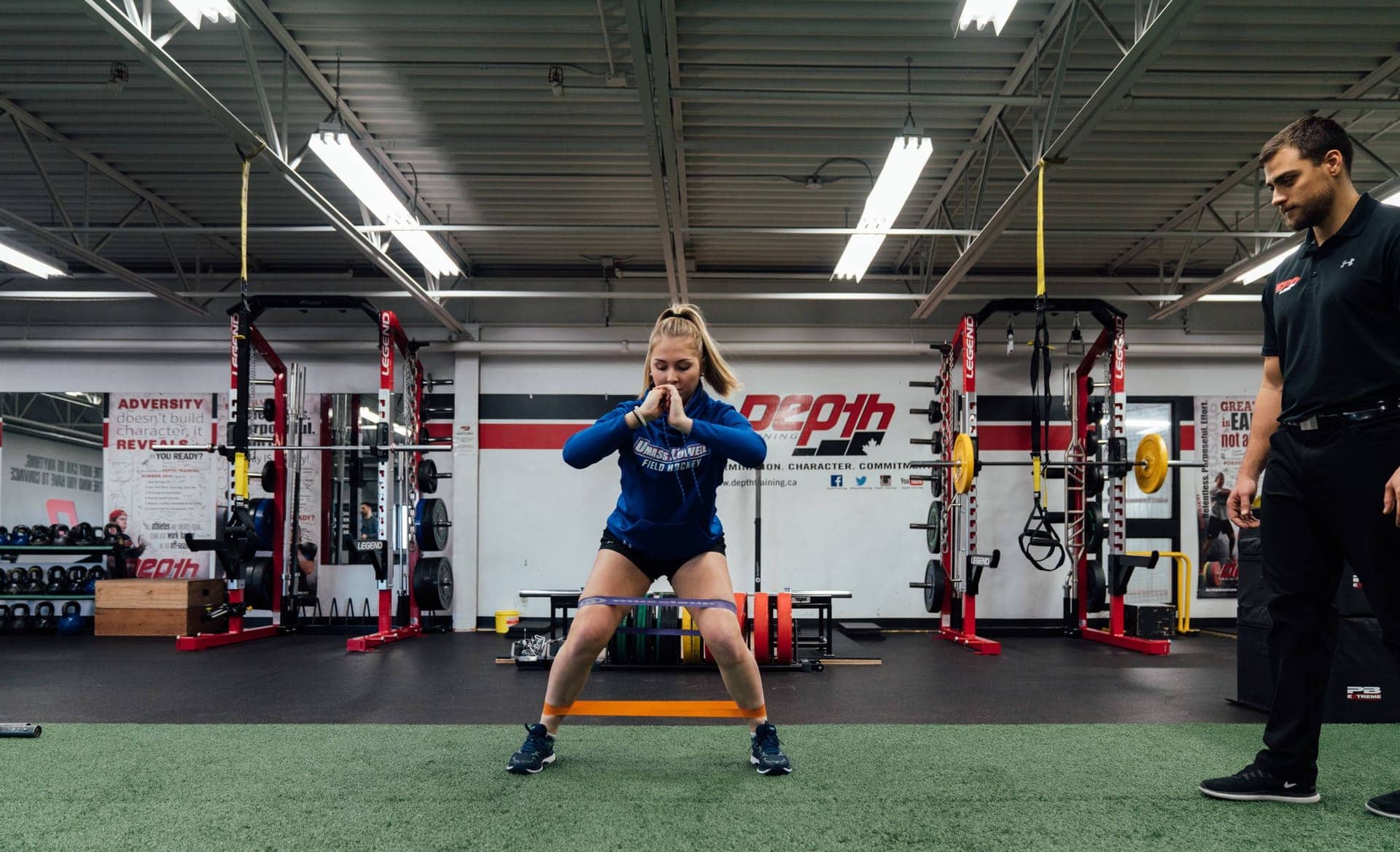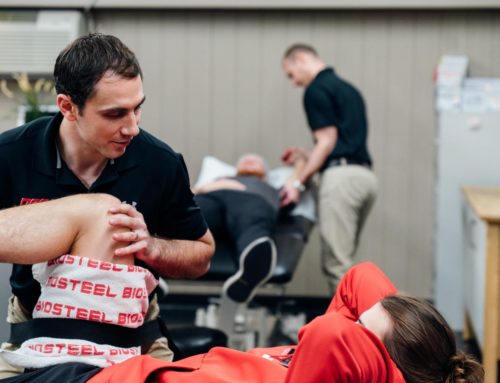Mini-bands have become a popular tool when it comes to training hockey players and for anyone wanting to build a better booty. They are a cost-effective and valuable asset when it comes to training for stronger legs and a more powerful stride.
The mini-band walk is a common method used by coaches, therapists and athletes to help develop stronger hip muscles.
This article shows you how to get more from your mini-band walks by highlighting some of the programming variables we use at Depth Training & Physiotherapy.
Some of the common mistakes I see made with mini-band training include:
- A lack of understanding on how band positioning effects difficulty.
- Failure to progress the exercises and diminishing returns.
- A lack of understanding on how body positioning affects difficulty and specificity of the exercise.
- Failure to set specific goals for measurable progress.
- Not prescribing or varying the tempo of the exercise.
Here are 4 ways you can get more specific with your mini-band exercise prescription and progressions to help you get the results you are after.
In PART 1 of this article we are going to focus on the first 2 ways to help you better program your mini-band walks.
-
Choose your band position
The band position is the first item you can prescribe to impact the degree of exercise difficulty.
At Depth, we use 5 basic band positions to progress loading with our band walks.
In order of easiest to most challenging:
- Above knee
- Ankle
- Mid-Foot
- Double mini-band, above knee + ankle
- Double mini-band, above knee + mid-foot
While there are more variations you could use, we find these 5 basic band positions provide enough variation and difficulty to keep making progress.
How to program?
Week 1, 2 – start with above knee and progress band strength

Week 3, 4 – ankle position and progress band strength

Week 5, 6 – mid-foot position and progress band strength

Week 7, 8 – Double mini-band, above knee + ankle

Week 9, 10 – Double mini-band, above knee + mid-foot

Week 11 – rest week, no band work
At the end of Week 11, return to week 1 and start with a stronger band, then continue to progress band strength to be greater than the first 10 weeks.
-
Choose your plane of movement.
The direction of your mini-band walk will have an impact on the specificity of training adaptation and we generally select from 3 basic planes:
1 – Lateral Walks (moving in the frontal plane)
- See videos above
2 – Forward and/or Backward Walks (moving in the sagittal plane)

3 – Zig-Zag or X-pattern Walks (moving in a combination of the frontal and sagittal plane)

You can select different movement planes to help with sport specificity, ie. when trying to improve linear (sagittal plane) or lateral (frontal plane) movement patterns for locomotion or if you just wanted to focus on a different aspect of the hip musculature.
We classify the 3 basic planes of movement as having the following benefits:
- Lateral Walks – lateral movement patterns, lateral change of direction skills, gluteus medius and hip external rotation strength
- Forward-Backward Walks – linear movement patterns, linear change of direction skills, gluteus maximus and hip flexor strength
- Zig-Zag or X-pattern Walks – this pattern all of the items listed for above in a general sense and none of them in a specific sense; this is a combination movement and is used to mimic the extension-abduction (stride out) and flexion-adduction (stride recovery) movements is acceleration sprinting and skating.
How to program?
Option 1:
- Select 1 drill from each plane and perform as part of your warm-up. The specific variation of the band drill can change each training day, but keep at least 1 drill from each plane in your warm-up or training routine.
Option 2:
- Have specific training days devoted to each plane of movement based on need (see below).
Advanced programming:
The number of exercises you select will depend on the training goal and will generally fall into 3 primary categories:
- High Priority for Improvement
- Moderate Priority for Improvement
- Maintenance
As a general rule, this is the number of drills you should complete each week for each plane of movement based on the training goal:
- High Priority for Improvement
- 3 sets of the exercise, 4 times per week
- Moderate Priority for Improvement
- 3 sets of each exercise, each exercise completed 3 times per week
- Maintenance
- 3 sets of each exercise, each exercise completed 2 times per week
Putting it all together
To help provide some programming context, let’s look at developing a 10-week mini-band program where the program goals are:
- High priority for improvement in frontal plane strength (Lateral Walks)
- 3 sets of the exercise, 2 times per week
- Moderate priority for improvement in sagittal plane strength (forward/backward walks)
- 3 sets of each exercise, each exercise completed 2 times per
- Maintenance for combination movements (zig-zag, x-pattern)
- 3 sets of each exercise, each exercise completed 1 time per week
*note, at Depth we use our individual athlete assessments to help determine exercise prescription needs or we emphasis specific planes of movement for specific training program phases based on the athlete’s sport.
Sample 5-day training cycle
Week 1 & 2
Band Position: Above Knee
Day 1: Lateral Walk, Forward/Backward Walk (3 sets each)
Day 2: Zig-Zag Walk (3 sets each)
Day 3: Rest
Day 4: Lateral Walk, Forward/Backward Walk (3 sets each)
Day 5: Lateral Walk (3 sets each)
Week 3 & 4
Band Position: Ankle
Day 1: Lateral Walk, Forward/Backward Walk (3 sets each)
Day 2: Zig-Zag Walk (3 sets each)
Day 3: Rest
Day 4: Lateral Walk, Forward/Backward Walk (3 sets each)
Day 5: Lateral Walk (3 sets each)
Week 5 & 6
Band Position: Mid-Foot
Day 1: Lateral Walk, Forward/Backward Walk (3 sets each)
Day 2: Zig-Zag Walk (3 sets each)
Day 3: Rest
Day 4: Lateral Walk, Forward/Backward Walk (3 sets each)
Day 5: Lateral Walk (3 sets each)
Week 7 & 8
Band Position: Double (Above Knee & Ankle)
Day 1: Lateral Walk, Forward/Backward Walk (3 sets each)
Day 2: Zig-Zag Walk (3 sets each)
Day 3: Rest
Day 4: Lateral Walk, Forward/Backward Walk (3 sets each)
Day 5: Lateral Walk (3 sets each)
Week 9 & 10
Band Position: Double (Above Knee & Mid-Foot)
Day 1: Lateral Walk, Forward/Backward Walk (3 sets each)
Day 2: Zig-Zag Walk (3 sets each)
Day 3: Rest
Day 4: Lateral Walk, Forward/Backward Walk (3 sets each)
Day 5: Lateral Walk (3 sets each)
Ahead in Part 2
In Part 2 of this article we will discuss the 3rd and 4th way to get more from your band walks:
- Choose your joint angle.
- Choose your rep scheme.
Bonus Tip: How to be more specific with your desired training quality (ie. strength, power or speed).
At the end of this 2 Part article series you should be able to take your mini-band programming to a whole new level!
Have a question? Email the author, Depth Training & Physiotherapy’s Director of Athletics Justin Brooks:
Written by: Justin Brooks, Director of Athletic Development, Registered Physiotherapist







Leave A Comment